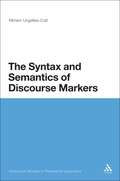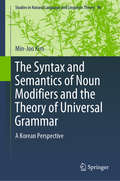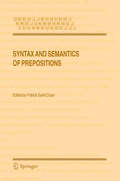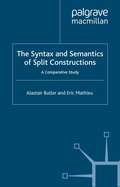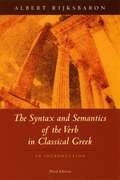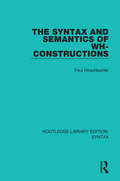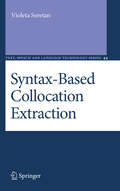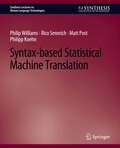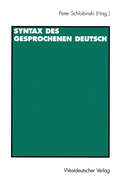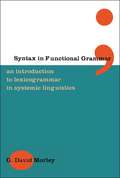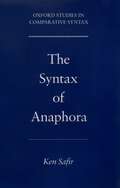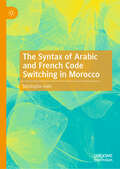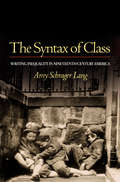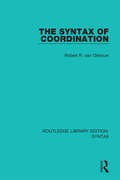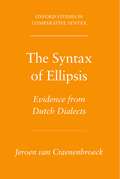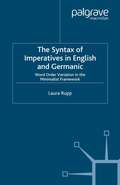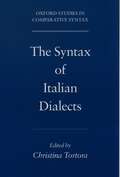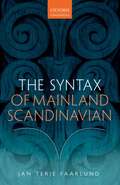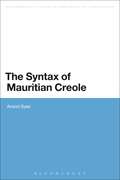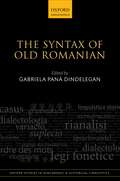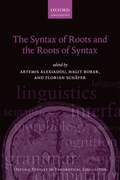- Table View
- List View
The Syntax and Semantics of Discourse Markers (Continuum Studies in Theoretical Linguistics)
by Miriam Urgelles-CollExamining the syntax and semantics of discourse markers, this book employs a syntactic approach to describe discourse markers in Head-Driven Phrase Structure Grammar (HPSG), relevant in a theory of discourse because it provides a framework in which all levels of grammar can be integrated. Since discourse markers operate at discourse level, a well developed discourse theory is required - in this case, Segmented Discourse Representation Theory (SDRT) is adopted. During the course of the book, Minimal Recourse Semantics is explained as it provides an integration of HPSG and SDRT. The approach described is exemplified with an analysis of 'anyway'. This book provides a detailed overview of research on discourse markers covering different areas of linguistics: from a discourse analysis point of view, to a Relevance Theory perspective going through a computational linguistics approach. Containing a precise summary of HPSG and the recently developed SDRT, it will be of great interest to researchers in semantics, pragmatics, grammar and discourse analysis.
The Syntax and Semantics of Noun Modifiers and the Theory of Universal Grammar: A Korean Perspective (Studies in Natural Language and Linguistic Theory #96)
by Min-Joo KimThis book takes Korean as a basis to provide a detailed universal Determiner Phrase (DP) structure. Adnominal adjectival expressions are apparently optional noun dependents but their syntax and semantics have been shown to provide an important window on the internal structure of DP. By carefully examining data from Korean, an understudied language, as well as from other unrelated languages, the book provides a broad perspective on the phenomenon of noun modification and its cross-linguistic variations. Furthermore, it offers not only a thorough syntactic analysis but also a formal semantic analysis of noun modifiers that extends beyond a single language. This book will be of great interest to researchers interested in theoretical syntax, its interfaces with semantics, pragmatics, linguistic typology, and language variation.
Syntax and Semantics of Prepositions (Text, Speech and Language Technology #29)
by Patrick Saint-DizierThis is the first book to provide an integrated view of preposition from morphology to reasoning, via syntax and semantics. It offers new insights in applied and formal linguistics, and cognitive science. It underlines the importance of prepositions in a number of computational linguistics applications, such as information retrieval and machine translation. The book presents a wide range of views and applications to various linguistic frameworks.
The Syntax and Semantics of Split Constructions: A Comparative Study
by A. Butler E. MathieuSplit constructions are very widespread in natural languages. The separation of the semantic restriction of a quantifier from that quantifier is a typical example of such a construction. This study addresses the problem that such discontinuous strings exhibit a number of locality constraints, including intervention effects. These are shown to follow from the interaction of a minimalist syntax with a semantics that directly assigns a model-theoretic interpretation to syntactic logical forms. The approach is shown to have wide empirical coverage and a conceptual simplicity. The book will be of interest to scholars and advanced students of syntax and semantics.
The Syntax and Semantics of the Verb in Classical Greek: An Introduction: Third Edition
by Albert RijksbaronThe verb is, in any language, the motor of all communication: no verb, no action. In Greek, verb forms change not only with person, number, tense, and voice, but in four possible moods as well. Available now in a special reprint for the North American market, The Syntax and Semantics of the Verb in Classical Greek is an incomparable resource to students and scholars charged with the considerable task of untangling the Greek language’s many complexities. With clear, concise instruction, Albert Rijksbaron shows how the various verb forms contribute to the richness of the Greek literature as we know it, in this essential guide for both novices and experienced practitioners. “[This study] belongs in the library of any Hellenist and any linguist interested in ancient Greek.”—Classics Newsletter (Anzeiger für die Altertumswissenschaft) “Every use is described with concision and clarity.”—Kratylos “The book offers an example of how the empirical thoroughness of traditional Classical scholarship can be brought into contact with general linguistic theory.”—Language
The Syntax and Semantics of Wh-Constructions (Routledge Library Editions: Syntax)
by Paul HirschbuhlerThis title, first published in 1985, provides a detailed analysis of aspects of the semantics and the syntax of some wh-constructions. The first part of the book deals with the semantics of questions, whilst the other part discusses the syntax of que and quoi (what) in questions in French and the syntax of free relatives in French and other languages. This title will be of interest to students of language and linguistics.
The Syntax and Semantics of Wh-Constructions (Routledge Library Editions: Syntax)
by Paul HirschbuhlerThis title, first published in 1985, provides a detailed analysis of aspects of the semantics and the syntax of some wh-constructions. The first part of the book deals with the semantics of questions, whilst the other part discusses the syntax of que and quoi (what) in questions in French and the syntax of free relatives in French and other languages. This title will be of interest to students of language and linguistics.
Syntax-Based Collocation Extraction (Text, Speech and Language Technology #44)
by Violeta SeretanSyntax-Based Collocation Extraction is the first book to offer a comprehensive, up-to-date review of the theoretical and applied work on word collocations. Backed by solid theoretical results, the computational experiments described based on data in four languages provide support for the book’s basic argument for using syntax-driven extraction as an alternative to the current cooccurrence-based extraction techniques to efficiently extract collocational data. The work described in Syntax-Based Collocation Extraction focuses on using linguistic tools for corpus-based identification of collocations. It takes advantage of recent advances in parsing to propose a novel deep syntactic analytic collocation extraction that has applicability to a range of important core tasks in Computational Linguistics. The book is useful for anyone interested in computational analysis of texts, collocation phenomena, and multi-word expressions in general.
Syntax-based Statistical Machine Translation (Synthesis Lectures on Human Language Technologies)
by Philip Williams Rico Sennrich Matt PostThis unique book provides a comprehensive introduction to the most popular syntax-based statistical machine translation models, filling a gap in the current literature for researchers and developers in human language technologies. While phrase-based models have previously dominated the field, syntax-based approaches have proved a popular alternative, as they elegantly solve many of the shortcomings of phrase-based models. The heart of this book is a detailed introduction to decoding for syntax-based models. The book begins with an overview of synchronous-context free grammar (SCFG) and synchronous tree-substitution grammar (STSG) along with their associated statistical models. It also describes how three popular instantiations (Hiero, SAMT, and GHKM) are learned from parallel corpora. It introduces and details hypergraphs and associated general algorithms, as well as algorithms for decoding with both tree and string input. Special attention is given to efficiency, including search approximations such as beam search and cube pruning, data structures, and parsing algorithms. The book consistently highlights the strengths (and limitations) of syntax-based approaches, including their ability to generalize phrase-based translation units, their modeling of specific linguistic phenomena, and their function of structuring the search space.
Syntax des gesprochenen Deutsch
by Peter SchlobinskiDer Band enthält zehn Beiträge zur Syntax des gesprochenen Deutsch. Die Beiträge sind empirisch fundiert, wobei syntaktische Strukturen in Gesprächssequenzen qualitativ und/oder quantitativ analysiert werden. Folgende Aspekte sind Gegenstand der Analyse: Wort- und Satzgliedstellung, Ellipsen, Selbstreparaturen, Parataxe, direkte und indirekte Rede, syntaktische Variation und Syntaxfehler in der Lernervarietät Deutsch. Die Syntaxanalysen beziehen pragmatische Faktoren mit ein, so daß die Analysen im weitesten Sinne strukturfunktional sind.
Syntax in Functional Grammar: An Introduction to Lexicogrammar in Systemic Linguistics
by G. David MorleyThis well-illustrated book outlines a framework for the analysis of syntactic structure from a perspective of a systematic functional grammar. In oart, the book goes back to the grammar's "scale and category" roots, but now with the aim of presenting how a descriptive framework illustrating how the analysis of the syntactic structure can reflect the meaning structure.The contents are divided into four sections. Section one gives a brief overview of systematic grammar, including the linguistic system, context of situation, and language fractions. Developing the lexicogrammar, section two considers formal units and their classes, but the principal focus is on section three, which covers the role of units as elements of structure. Section four discusses areas of structural complexity and concludes with several refinements to the analysis format.
The Syntax of Anaphora (Oxford Studies in Comparative Syntax)
by Ken SafirIn this work, Ken Safir develops a comprehensive theory on the role of anaphora in syntax. First, he contends that the complementary distribution of forms that support the anaphoric readings is not accidental, contrary to most current thinking, but rather should be derived from a principle, one that he proposes in the form of an algorithm. Secondly, he maintains that dependent identity relations are always possible where they are not prohibited by a constraint. Lastly, he proposes that there are no parameters of anaphora - that all anaphora-specific principles are universal, and that the patterns of anaphora across languages arise entirely from a restricted set of lexical properties. This comprehensive consideration of anaphora redirects current thinking on the subject.
The Syntax of Arabic and French Code Switching in Morocco
by Mustapha AabiThis book posits a universal syntactic constraint (FPC) for code switching, using as its basis a study of different types of code-switching between French, Moroccan Arabic and Standard Arabic in a language contact situation. After presenting the theoretical background and linguistic context under study, the author closely examines examples of syntactic constraints in the language of functional bilinguals switching between French and forms of Arabic, proposing that this hypothesis can also be applied in other comparable language contact and translanguaging contexts worldwide. This book will be of interest to students and scholars of French, Arabic, theoretical linguistics, syntax and bilingualism.
The Syntax of Class: Writing Inequality in Nineteenth-Century America
by Amy Schrager LangThe Syntax of Class explores the literary expression of the crisis of social classification that occupied U.S. public discourse in the wake of the European revolutions of 1848. Lacking a native language for expressing class differences, American writers struggled to find social taxonomies able to capture--and manage--increasingly apparent inequalities of wealth and power. As new social types emerged at midcentury and, with them, new narratives of success and failure, police and reformers alarmed the public with stories of the rise and proliferation of the "dangerous classes." At the same time, novelists as different as Maria Cummins, Nathaniel Hawthorne, Frank Webb, Elizabeth Stuart Phelps, and Horatio Alger Jr. focused their attention on dense engagements across the lines of class. Turning to the middle-class idea of "home" as a figure for social harmony and to the lexicons of race and gender in their effort to devise a syntax for the representation of class, these writers worked to solve the puzzle of inequity in their putatively classless nation. This study charts the kaleidoscopic substitution of terms through which they rendered class distinctions and follows these renderings as they circulated in and through a wider cultural discourse about the dangers of class conflict. This welcome book is a finely achieved study of the operation of class in nineteenth-century American fiction--and of its entanglements with the languages of race and gender.
The Syntax of Class: Writing Inequality in Nineteenth-Century America
by Amy Schrager LangThe Syntax of Class explores the literary expression of the crisis of social classification that occupied U.S. public discourse in the wake of the European revolutions of 1848. Lacking a native language for expressing class differences, American writers struggled to find social taxonomies able to capture--and manage--increasingly apparent inequalities of wealth and power. As new social types emerged at midcentury and, with them, new narratives of success and failure, police and reformers alarmed the public with stories of the rise and proliferation of the "dangerous classes." At the same time, novelists as different as Maria Cummins, Nathaniel Hawthorne, Frank Webb, Elizabeth Stuart Phelps, and Horatio Alger Jr. focused their attention on dense engagements across the lines of class. Turning to the middle-class idea of "home" as a figure for social harmony and to the lexicons of race and gender in their effort to devise a syntax for the representation of class, these writers worked to solve the puzzle of inequity in their putatively classless nation. This study charts the kaleidoscopic substitution of terms through which they rendered class distinctions and follows these renderings as they circulated in and through a wider cultural discourse about the dangers of class conflict. This welcome book is a finely achieved study of the operation of class in nineteenth-century American fiction--and of its entanglements with the languages of race and gender.
The Syntax of Coordination (Routledge Library Editions: Syntax)
by Robert R. van OirsouwCoordination is a syntactic construction which occurs in most languages. In the past, it has been a fruitful area of research, but also a controversial one. Arguments from coordination have been used in support of transformations, and against phrase-structure rules, but also in support of phrase-structure rules and against transformations. This
The Syntax of Coordination (Routledge Library Editions: Syntax)
by Robert R. van OirsouwCoordination is a syntactic construction which occurs in most languages. In the past, it has been a fruitful area of research, but also a controversial one. Arguments from coordination have been used in support of transformations, and against phrase-structure rules, but also in support of phrase-structure rules and against transformations. This
The Syntax of Ellipsis: Evidence from Dutch Dialects (Oxford Studies in Comparative Syntax)
by Jeroen Van CraenenbroeckThe Syntax of Ellipsis investigates a number of elliptical constructions found in Dutch dialects within the framework of the Minimalist Program. Using two case studies, Van Craenenbroeck argues that both the PF-deletion and the pro-theory of ellipsis are needed to account for the full range of elliptical phenomena attested in natural language. The first case study focuses on instances of stranding to the right of a sluiced wh-phrase: prepositions in English (What about?) and demonstrative pronouns in southern Dutch dialects (Wie dat? 'who that'). Van Craenenbroeck gives both of these phenomena a PF-deletion analysis, which turns out to have considerable repercussions for the structure of the left periphery and the syntax of wh-movement. Specifically, while minimal wh-phrases move from their IP-internal base position to specCP, complex ones are base-generated in the (split) left periphery. The second case study is concerned with Short Do Replies in southern Dutch dialects, a type of contradictory reply that at first sight bears a close resemblance to English VP-ellipsis. Van Craenenbroeck shows that in this case the ellipsis site is best represented as a null, structureless proform that is licensed by the head of a high PolP. Moreover, this pronominal is argued to occur in two other dialectal constructions as well: contradictory replies of the type Da's nie 'that is not' found in Brabant Dutch, and the occurrence of subject clitics and agreement endings on the words for yes and no in Southern Dutch dialects (e.g. Ja-n-s 'yes-PLURAL-they'). The Syntax of Ellipsis will be of interest to scholars of the left periphery, wh-movement, and Dutch dialects.
The Syntax of Imperatives in English and Germanic: Word Order Variation in the Minimalist Framework
by L. RuppThis volume examines several aspects of the syntax of imperative clauses in English and in a variety of other Germanic languages in the context of the challenge that apparent optional movement poses for the Minimalist Programme.
The Syntax of Italian Dialects (Oxford Studies in Comparative Syntax)
by Christina TortoraThis volume collects original theoretical work on the syntax and morphology of Italian and a wide range of Italian dialects. It contains contributions by such leading figures as Cecilia Poletto, Guglielmo Cinque, and Richard Kayne, and examines topics such as the syntax of "ne", the internal structure of personal pronouns, the syntax/morphology interface, and functional projections at the clausal level.
The Syntax of Mainland Scandinavian
by Jan Terje FaarlundThis book explores the syntactic structures of Mainland Scandinavian, a term that covers the Northern Germanic languages spoken in Denmark, Norway, Sweden, and parts of Finland. The continuum of mutually intelligible standard languages, regional varieties, and dialects stretching from southern Jutland to eastern Finland share many syntactic patterns and features, but also present interesting syntactic differences. In this volume, Jan Terje Faarlund discusses the main syntactic features of the national languages, alongside the most widespread or typologically interesting features of the non-standard varieties. Each topic is illustrated with examples drawn from reference grammars, research literature, corpora of various sorts, and the author's own research. The framework is current generative grammar, but the volume is descriptive in nature, with technical formalities and theoretical discussion kept to a minimum. It will hence be a valuable reference for students and researchers working on any Scandinavian language, as well as for syntacticians and typologists interested in Scandinavian facts and data without necessarily being able to read Scandinavian.
The Syntax of Mauritian Creole (Bloomsbury Studies in Theoretical Linguistics)
by Anand SyeaCreolelanguages have in recent years become a valuable source of data for currenttheories of syntax and theories of child/adult languageacquisition. However, grammars of these languages, particularly thosecouched within theoretical frameworks of one kind of another, are few and farbetween. This book contributes directly to creole linguistics by providing adetailed study of different aspects of the syntax of Mauritian creole withinthe theoretical framework of Principles and Parameters (Chomsky, 1981) andMinimalism (1995). It gives the reader a detailed account of the structureof this language and insight into the nature of creole languages, withimplications for current cartographic and minimalist thinking on the structureand derivation of phrases and clauses. It will appeal to researchers ofgrammar and syntax, language acquisition, contact linguistics andsociolinguistics.
The Syntax of Mauritian Creole (Bloomsbury Studies in Theoretical Linguistics)
by Anand SyeaCreolelanguages have in recent years become a valuable source of data for currenttheories of syntax and theories of child/adult languageacquisition. However, grammars of these languages, particularly thosecouched within theoretical frameworks of one kind of another, are few and farbetween. This book contributes directly to creole linguistics by providing adetailed study of different aspects of the syntax of Mauritian creole withinthe theoretical framework of Principles and Parameters (Chomsky, 1981) andMinimalism (1995). It gives the reader a detailed account of the structureof this language and insight into the nature of creole languages, withimplications for current cartographic and minimalist thinking on the structureand derivation of phrases and clauses. It will appeal to researchers ofgrammar and syntax, language acquisition, contact linguistics andsociolinguistics.
The Syntax of Old Romanian (Oxford Studies in Diachronic and Historical Linguistics #19)
This book provides the first comprehensive overview of the syntax of old Romanian written in English and targeted at a non-Romanian readership. It draws on an extensive new corpus analysis of the period between the beginning of the sixteenth century, the date of the earliest attested Romanian texts, and the end of the eighteenth century, generally considered to mark the start of the modernization of Romanian. Gabriela Pană Dindelegan and her co-authors adopt both a synchronic and diachronic approach by providing a detailed corpus analysis in a given period, while also comparing old and modern Romanian. They examine the evolution of a variety of syntactic phenomena, including the elimination or diminishing of certain facts or generalization of others, the total or partial grammaticalization of phenomena, competition between structures, and cases of syntactic variation. The book takes a typological and comparative perspective, focusing on those phenomena that are considered specific to Romanian (either on the Romance or in the Balkan area), and adopts a modern framework while still remaining accessible to readers from any background.
The Syntax of Roots and the Roots of Syntax (Oxford Studies in Theoretical Linguistics #51)
This book investigates the nature and properties of roots, the core elements of word meaning. In particular, chapters examine the interaction of roots with syntactic structure, and the role of their semantic and morpho-phonological properties in that interaction. Issues addressed in the book include the semantics and phonology of roots in isolation and in context; the categorial specification of roots; and the role of phases in word formation. Internationally recognized scholars approach these topics from a variety of theoretical backgrounds, drawing on data from languages including German, Hebrew, and Modern Greek. The book will be of interest to linguistics students and researchers of all theoretical persuasions from graduate level upwards.
